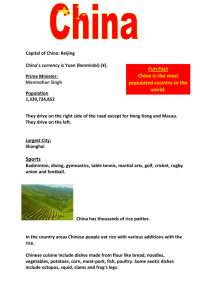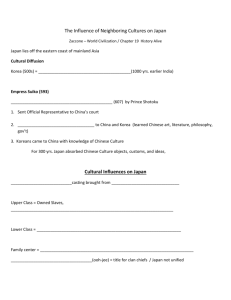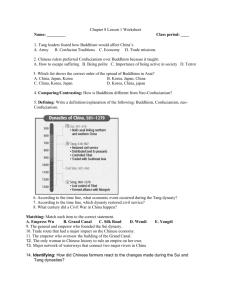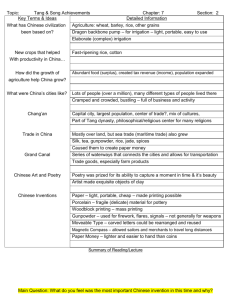Chapter 11 - ripkensworldhistory2
advertisement
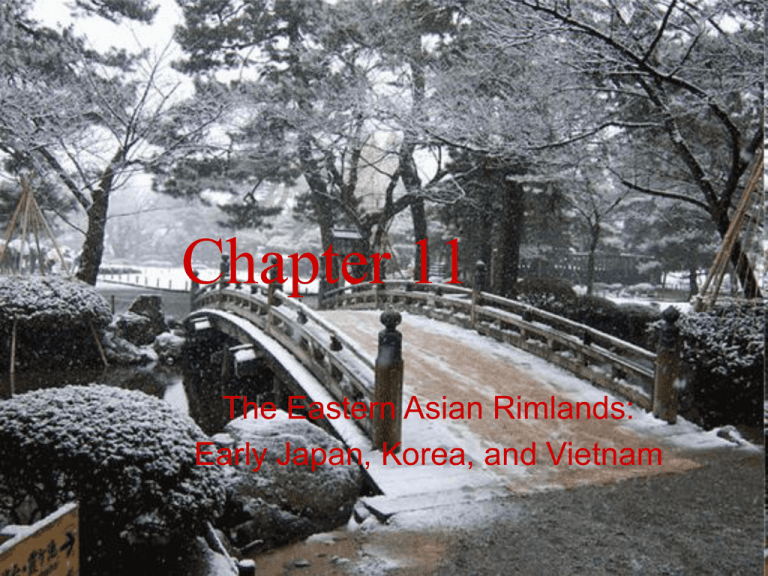
Chapter 11 The Eastern Asian Rimlands: Early Japan, Korea, and Vietnam Japan Land of the Rising Sun Japan is an Island country 4 main islands Hokkaido (north) Honshu (center) Kyushu and Shikoku (south) Temperate Climate especially in the East 3 major cities Tokyo, Osaka, and Kyoto Geography Mountainous – volcanic – creates fertile soil 20% total land is suitable for cultivation = 2 crops/year Located on Asian and Pacific tectonic plates – prone to earthquakes Film Clip: Days that Shook the World: Japan 1923 Origins Izanagi and Izanami – god and goddess their union creates Japan Give birth to Amaterasu which then becomes the founder of society This gives credence to the Emperors to come Origins Con’t Evidence of humans at least 100,000 years Jomon 10,000 years ago pottery evidence 400 BCE – Korean immigrants Yayoi culture come to Japan along with rice crops will spread to northern islands Yayoi Culture Settle predominately in Yamato Plain (near the modern cities of Osaka and Kyoto) Tribal Society called Uji Ruled by hereditary chieftain Protection for portion of harvest Population divided into: Aristocratic class Majority of Population Rice farmers Artisans Household servants Yayoi Con’t Highly decentralized society Although, dominant clan in the Yamato region claimed to be descendent of Amaterasu and did contain some measure of power. The Rise of the Japanese State Do to the potential threat of China, Japan reorganized itself: 1) Created alliances with remaining Korean States 2) Centralized authority to reset a Chinese invasion Shotoku Taishi (562 - 622) Key, dominant figure in Yamato region Sent missions to Chang’an (Tang) to learn political institutions to strengthen centralization Taishi Reforms: Creates 17 Article Constitution (pg 294) Supreme ruler and a merit system for selecting and ranking public officials, Limited the power of hereditary nobility Enhanced the prestige and authority of the Yamato ruler Taika – the great change Creation of the Grand Council of State Cabinet of 8 ministries Japan divided into administrative districts Rural villages run by chiefs Overseer of the household registers Assigning of the sowing of crops and cultivation Rice and mulberry trees Prevention of offences Requisition of taxes and forced labour New Tax System: New tax and law system creates centralized taxes Land is now owned by the state Taxes now paid directly to the state Introduction of Buddhism into the country The Nara (710-784) and Heian (794-1185) Periods These periods = a time of decentralization To avoid taxes land was given up to high ranking aristocrats who were exempt from paying taxes Result – centralized government loses influence and strategic marriages bind strong factions together Rural Clans continued to become more powerful especially with the introduction of the samurai. Clans become militant The Samurai Lived life of simplicity and self-sacrifice Followed Bushido or warrior code Strict loyalty bonded samurai class Become a major political and military force in the country side. See bookmarked sites The Kamakura Shogunate Civil war ensues as decentralization occurs Re-Centralization occurs under the leadership from a warrior clan: Minamoto Yoritomo (11421199) Sets up power base at Kamakura peninsula Shogunate System: Centralized government Bakufu Powerful Military under leadership of the Shogun Emperor exist but is a figure had to the Shogun System will continue into the second half of the 19th C. Time of Unrest Mongol Invasion Late 13th C Ashikaga Period 1333 – 1600 Invasion tried twice Second invasion conquered by Kamikaze “divine wind) Typhoon Decentralization rampant Daimyo (great names) are ruling creating a loose coalition of families ruling together Onin War 1462-1477 Destruction of Capital City of Kyoto Disintegration of the Shogunate Powerful Aristocrats seize large territories and rule independently Warring common until 16th C when centralization returns Economic and Social Structure Agricultural society based on “wet rice” Economic Con’t Commerce slow to develop in Japan Uji – made up of weavers, carpenters and ironworkers trade though is regulated and limited to clan leaders Yamato state money economy gradually develops although barter is common Kamakura Period Trade and manufacturing develop Appearance of Tri-monthly markets Emergence of industry: paper, iron casting, and porcelain Foreign trade with Korea and China Japanese Exports: raw materials, paintings, swords Japanese Imports: silk, porcelain, books, copper cash Ashikaga Period Rapid growth of wealth and authority of daimyo families create market towns Full money economies Local manufacturers form gilds – Zaivatsu Monopolies on product industry – apprentice, journeyman, master includes rice, samurai swords etc. Rice famines Social Life Common People Top officials – well to do peasants – responsible for organizing collective labour services and collecting tax grain and so are exempt from taxes Peasents Genin – Landless labour Eta – Hereditary slaves Gender Roles Women and men share importance early on as both are needed to perform tasks to survive Polygamy common 8th C law code guaranteed inheritance rights of women, and wives abandoned by husbands were permitted to divorce and remarry Husbands could divorce if a male child wasn’t produced, committed adultery, disobeyed parents in law, talked too much, engaged in theft was jealous or had a serious illness! With the introduction of Buddhism women were subordinate in position Religion Early belief – worship of nature spirits: Kami and ancestor spirits Evolve into Shinto the state religion Ritualistic acts at a shrine Process of purification Stress on the importance and beauty of nature Becomes a state doctrine linked the divinity of the emperor and Japanese nation Buddhism Introduced in 6th C CE Create a Shinto/Buddhism combination in a symbiotic relationship Two sects 1) Pure Land sect – common people Devotion alone could lead to enlightenment and release 2) Zen Buddhism – compliment traditional beliefs Austerity self-discipline and communion of nature Korea Major influences from China Korea is divided into the Three Kingdoms 4th to 7th C Kings bitter rivalry for influence and territory on the peninsula All absorb political and cultural influence from China Koguryo influenced by Buddhism in the late 4th C Kingdoms share a tributary relationship with China Silla has strong internal cohesion due to location from China will become dominant power Silla Kingdom Force Chinese from all of Korea except Yalu River Accepts tributary status under the Tang Attempted to use Chinese political model for centralization Buddhism rising in popularity Chinese architecture, art, and written language become popular No civil service examination system or distribution manorial lands to the poor Sulla king assassinated in 780 country sinks into civil war Koryo Dynasty Arose in the North Adopted Chinese political model Civil Service exam system introduced in 958 Industry and commerce slowed develop Agriculture premier source of wealth King and noble families hold land Base people composed of slaves, artisans, and specialized workers Mongol Rule Koryo unable to overcome the power of the nobility and the absence of a reliable tax base Koryo becomes a tributary to Khan Profound suffering to the Korean people for peasants and artisans Introduction of new ideas and technology With the rise of the Ming in China Koryo collapses Power now in the hands of Military commander Yi Song-gye Yi dynasty in 1392 Vietnam – The Smaller Dragon By 200 BCE – a young state began to form Immediately felt pressure by the Qin Dynasty in China Vietnamese gain independence after the Qin collapse A Century later absorbed into the Han Empire Started autonomous region under the administration of the local landed aristocracy Chinese taxes are oppressive and in 39 CE revolt led by Trung Sisters bring an end to Han rule Cont Chinese suppress the rebellion and begin to rule directly Intermarriages between the SinoVietnamese elite identirfy with Vietnamese autonomy Art, architecture, literature, philosophy and written language of the Chinese adopted Seen as part of China The Rise of the Great Viet In the 10th C – Vietnamese strengthened by a sense of ethnic and cultural identity overthrow Chinese rule with the collapse of the Tang Dynasty Dai Viet becomes a new force on the South-east Asian mainland Dai Viet – take on Champa and the Gulf of Siam and Mongols – being successful! Use of guerrilla warfare Chinese Legacy Confucian model followed Ruler styled like Chinese Emperor Adopted Chinese court rituals, claimed Mandate of Heaven Chinese political model adopted including civil service exam Spread of Buddhism, Daoism and Confucianism

